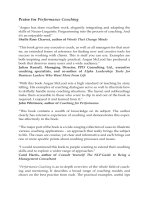Coaching the Team at Work potx
Bạn đang xem bản rút gọn của tài liệu. Xem và tải ngay bản đầy đủ của tài liệu tại đây (1.01 MB, 286 trang )
Coaching the Team
at Work
Coaching the Team
at Work
DAVID CLUTTERBUCK
First published by
N
icholas Brealey International in 2007
3–5 Spafield Street 20 Park Plaza
Clerkenwell, London Boston
EC1R 4QB, UK MA 02116, USA
Tel: +44 (0)20 7239 0360 Tel: (888) BREALEY
Fax: +44 (0)20 7239 0370 Fax: (617) 523 3708
www.nicholasbrealey.com
www.clutterbuckassociates.com
© David Clutterbuck 2007
The right of David Clutterbuck to be identified as the author of this work has
been asserted in accordance with the Copyright, Designs and Patents Act 1988.
ISBN-13: 978-1-904838-08-1
ISBN-10: 1-904838-08-1
Library of Congress Cataloging-in-Publication Data
Clutterbuck, David.
Coaching the team at work / David Clutterbuck.
p. cm.
Includes bibliographical references.
1. Employees Coaching of. 2. Teams in the workplace Management. 3.
Organizational learning Management. 4. Employee motivation. I. Title.
HF5549.5.C53C58 2007
658.3'124 dc22
2006101499
British Library Cataloguing in Publication Data
A catalogue record for this book is available from the
British Library.
All rights reserved. No part of this publication may be reproduced, stored in a
retrieval system, or transmitted, in any form or by any means, electronic,
mechanical, photocopying, recording and/or otherwise without the prior written
permission of the publishers. This book may not be lent, resold, hired out or
otherwise disposed of by way of trade in any form, binding or cover other than
that in which it is published, without the prior consent of the publishers.
Printed in Finland by WS Bookwell.
Contents
Introduction 1
1 WHAT IS COACHING? 9
Approaches to coaching 10
Coaching compared to mentoring 18
Coaching compared to counselling and therapy 19
Taking an integrated approach 20
The key steps in a coaching intervention 22
Identify the need to improve/change 22
Observe and gather evidence 23
Motivate to set and own personal improvement
targets 23
Help to plan how to achieve those targets 25
Create opportunities to practise the desired skills 26
Observe in action and give objective feedback 26
Help to work through setbacks
27
The coaching conversation 28
What good coaches do 31
Competences of the coachee 33
2 DEFINING THE TEAM 37
What is a team?
38
Types of team 43
Team size 52
The value of multiple perspectives 54
What makes a team effective? 55
Diverse or similar: Which is best? 55
Cultural diversity 56
Expertise diversity 58
v
Gender mix 58
Creativity and work standardization 59
Communication 61
Conflict 63
Role of the leader 67
Teamwork 70
How teams evolve 72
The coach’s repertoire 74
3 COACHING THE TEAM 77
The business case for team coaching 79
Improving performance 79
Making things happen faster 81
Making things happen differently 81
The complexities of team coaching 83
Confidentiality 83
Relationship scope 87
Reaching decisions 88
Models of team coaching 94
Coaching or facilitation? 101
Team leading or team coaching? 101
Team building or team coaching?
108
Coaching the top team 113
What effective team coaches do 117
Preparing the team to be coached 121
Becoming truly effective 122
4
CO
ACHING THE LEARNING TEAM
123
What is a learning team? 125
Learning goals, processes and outcomes have an
owner 126
A wide variety of learning resources is used 126
People share their knowledge and learning 127
The leader creates an environment suitable for
learning 127
COACHING THE TEAM AT WORK
vi
Dialogue produces more than discussion or debate 128
Reflective space is allowed for 131
Energy is spent on balancing the focus on task
completion, learning and behaviour 132
Alternative views of team learning 135
Team learning and team knowledge 136
The climate for team learning 139
Psychological safety and team learning 140
Learning and diversity: Difference of perspective 141
Creating the environment for team learning 145
Six types of team for learning 148
Learning in each of the six team types 153
Coaching stable teams 154
Creating and maintaining the stimulus for
challenging and reflecting on tasks, processes
and relationships 155
Recognizing and identifying the “elephant
in the room” 156
Establishing the cycle of coaching intervention 157
Putting greater depth and quality into
communication systems and networks 158
Inducting new team members 158
Coaching cabin crew teams 160
Coaching project teams 163
Project teams as vehicles for learning 166
Coaching evolutionary teams 169
Making tacit knowledge explicit 170
V
aluing new and past contributions
171
Recognizing and managing phase transitions 172
Coaching virtual teams 172
Coaching learning alliances 180
The team learning process 185
Setting the goals for learning 186
Organizing learning 188
Reviewing learning 190
CONTENTS
vii
COACHING THE TEAM AT WORK
viii
Sharing learning 191
Recognizing and rewarding learning 192
Building the learning team 193
How behaviours support the learning team 195
The role of the team leader 197
How ready is your team for learning? 198
5 MANAGING TEAM COACHING 199
Managing interpersonal dynamics 200
Helping the team manage conflict 201
Conflict source analysis 203
Raising the emotional intelligence of the team 207
Developing collective self-belief 211
Managing stress within the team 212
Creating the climate for team coaching 214
Temporal issues 217
Just-in-time team coaching 217
Temporal orientation 219
Time management 220
Managing key processes 224
Achieving goal clarity 225
What does the team actually do? 226
Analysing the team functioning 226
Raising the creativity of the team 230
Systemic thinking 231
Decision making 232
Communication 234
Evaluating the impact of team coaching
237
Expect the unexpected 239
6 THE SELF-COACHING TEAM 241
Managing the transition to self-coaching 241
Finding their own difficult questions 242
Tracking down new knowledge 243
Taking over the coaching process 244
Generating feedback 244
Self-motivated learning 245
Creating the environment for the self-coaching team 245
Balance the focus on task, learning and behaviour 246
Create frequent opportunities for learning dialogue,
both formal and informal 247
Feel comfortable with the uncomfortable 247
Manage the team learning process 248
Protect team learning from external derailers 248
How team learning roles support the self-coaching team 249
The self-coaching team and succession planning 252
Learning to coach other teams 253
Handing over the coaching process 255
Prepare the ground at an early stage 255
Excite the team about doing things for itself 256
Transfer ownership of process along with ownership
of solutions 256
Equip the team to find multiple sources of support
and reflection in the future 257
The ultimate goal 258
Notes 259
Index 272
CONTENTS
ix
W
hile a great deal has been written about coaching indi-
viduals, there has been relatively little investigation of
coaching teams at work. Yet in discussions with senior
human resource and organizational development professionals, this
ability is consistently cited as one of the most serious weaknesses in
the capability set of managers at all levels. Even in organizations
that have made considerable steps towards becoming coaching cul-
tures,
1
the focus of attention for that coaching is the individual.
However, few people in organizations work alone. Indeed, the
whole point of having an organization is to harness the collective
efficiency of people working together. Peter Senge makes the point
succinctly when he says:
Knowledge generation . . . primarily occurs in working
teams. Individual learning is a by-product of what goes
on in really innovative teams. But individual learning is
not the goal. In fact, if it becomes the goal, you are in
trouble.
2
Organizations employ teams because they have found that this is a
more effective way to organize complex work than any alternative
yet designed. T
eams pr
ovide the bridges between individuals and
the organization; and between the need to make localized decisions
and customize, and the requirement to adhere to large-scale plans
and strategies. Teams also provide the focus of activity that meets
people’s needs for socialization. They establish the environment
where people can share effort, reward and risk. They provide a sense
of common identity, rooted in shared ideas, purpose, stories and
attitudes. And they provide an opportunity for conversation,
1
support, recognition and other activities that make people feel
motivated and raise self-esteem.
Unfortunately, teams don’t always live up to their promise. The
depressing evidence is that many, if not most, teams in the modern
workplace do not harness their collective capability to anything like
the extent that they could. Failures of structure and process, lack of
purpose or commitment, internal conflict and poor leadership sap
the team’s potential to work at its optimal level. Some of this loss of
performance is inevitable – a simple dynamic of team size, for exam-
ple – but most is readily manageable, if team members and leaders
are minded to reflect intelligently on how they operate and have the
skills to do so.
This is where team coaching can be beneficial. It helps teams
review performance, boost results, improve communication and
build rapport.
Very few goals at team or organizational level can be achieved
without some form of performance management process. While
addressing the issues that emerge from performance review at an
individual level is helpful, in practice most issues involve interaction
between team members or in some way have an impact on other
members. Addressing performance solely at the level of individuals
may be much less effective than engaging all the players in the issue.
The more that other team members understand what is needed to
help a fellow team member improve performance, the more achiev-
able and sustainable that improvement is likely to be.
Secondly, team coaching, as we shall explore in the following
chapters, is a significant part of the remedy for team performance
shortfalls. It harnesses a combination of intelligence and curiosity to
help teams think through what they are doing and why, how they
will integrate individual skill sets and how they will innovate. It also
helps the team ask questions that will stimulate the intellectual dia-
logue necessary for addressing performance issues effectively.
Team coaching also fosters a higher quality of communication,
both within the team and between the team and external stake-
holders in its activities, ensuring that the dialogue is both intellec-
COACHING THE TEAM AT WORK
2
tual and emotional in character and content. And team coaching
promotes the social dialogue that builds rapport, stimulates under-
standing of self and other team members, and develops the skills to
avoid negative conflict and enhance positive conflict within the
team.
The aim of this book is to bridge the gap between the limited
but growing academic literature on both team learning and team
coaching, and the practical experience of managers and workplace
coaches. Some of the questions it attempts to answer are:
◆ How is coaching the team different from coaching individuals,
and from other processes such as facilitation?
◆ What skills underpin effective team coaching?
◆ What is the responsibility of team members in this process?
◆ How do you know when team coaching has been effective?
◆ When is team coaching appropriate and when will other
approaches deliver better results?
◆ How can organizations make team coaching a sustainable,
automatic process?
Along the way, we demolish a number of myths about teams and
coaching. Among these are the following:
◆ Teamwork is always better than working alone. Not true. A
whole range of social factors conspires to undermine the effi-
ciencies expected from working collaboratively. Research into
team effectiveness suggests that limited collaboration (where
everyone does their own thing, with clear guidelines and occa
-
sional liaison) often delivers better results than trying to get
everybody to work together. Like any other organism, teams
are subject to chronic diseases, such as social loafing (where
everyone eases off a bit on the assumption that others will take
up the slack). Nonetheless, well-managed teams, used in the
right circumstances and for the right purposes, are the bedrock
of a high-performing organization.
INTRODUCTION
3
◆ Coaching is the responsibility of the team leader. Not true.
If coaching is to work, it has to be the responsibility of the team
as a whole. There are no spectators. The management of the
coaching process belongs to both coaches and coachees.
◆ The coach is the team leader. Not necessarily. The role of the
team leader is to create the environment where coaching hap-
pens, and to provide an example of good coaching practice (as
both coach and coachee) for other team members to follow.
Peer coaching is as important and frequently more important
for a team’s success than coaching from the team leader or from
someone outside.
◆ Coaching within the team is an occasional activity. Not
when it’s at its most effective. In reality, the more coaching
becomes integrated with day-to-day activities and processes, the
greater and more lasting its impact on performance.
◆ Team coaching is about task performance. Partially true. But
sustainable improvements in task performance are the result of
effective management of three aspects of team focus: achieving
the task; managing continuous, relevant learning at both the
operational and the wider contextual levels; and managing
behaviour within the team and between the team and external
stakeholders. It is the integration of these aspects that pr
ovides
the foundation for teams that are successful over the long term.
About the book
The learning journey of this book follows a logical series of steps –
just like coaching – starting with the nature of coaching and ending
with helping the team make the decision to self-coach. On the way,
we take a variety of detours that seem interesting and relevant – just
like coaching. And we try to create insights by asking difficult ques-
tions – just like coaching. And if we spend some time in didactic
mode, well, it is a book, isn’t it? So what do we cover?
COACHING THE TEAM AT WORK
4
In Chapter 1, we review the nature and processes of
coaching:
◆ Where does the instinct to coach come from?
◆ How is coaching different from facilitation, mentoring, coun-
selling and other forms of helping people look inwards to learn
and grow?
◆ Why has coaching expanded in popularity so dramatically in
recent years?
◆ What’s the difference between effective and ineffective
coaching?
In Chapter 2, we take a look at the nature of the team itself:
◆ What’s the difference between a team and a group? Does it
matter?
◆ What are the dynamics that underlie team effectiveness and
how do they manifest themselves?
Chapter 3 focuses on the role and practice of coaching within the
team, answering questions such as:
◆ Who does it? To whom?
◆ When is the best time to coach the team?
◆ How does coaching the team differ from coaching individuals
and how can both processes be integrated for the team’s collec-
tive benefit?
◆ How can the team coach foster a coaching cultur
e?
◆ When is it appropriate for the coach to be the team leader and
when should the coach be an external professional?
In Chapter 4, we progress to considering the processes of learning
within teams generally and within each of six key team types. We
ask:
INTRODUCTION
5
◆ What helps and hinders learning?
◆ How do teams increase the quantity and quality of the learning
they experience?
◆ What should the coach do with each type of team?
In Chapter 5, we examine in more detail the issues that the team
coach needs to manage and the skill sets required to do so. We pres-
ent a framework for organizing team coaching and for developing
the relevant skills. Among questions we ask are:
◆ How do you know you are coaching the team well?
◆ How do you avoid becoming too cosy?
◆ What is the right level and kind of conflict for an effective team?
We also offer some suggestions of useful techniques and approaches
to cope with common issues that arise in team coaching, relating to
the management of interpersonal relationships, temporal issues, and
key processes such as goal setting, systems thinking and
communication.
Chapter 6 brings the emphasis of team coaching back to the
team members, where it belongs, asking:
◆ How can the team members ensure that they take responsibil-
ity for coaching themselves and each other?
◆ What can they do to assist the leader or an external coach in
building the coaching habit?
◆ What help do both need from the organization?
Throughout the book are case studies drawn from countries as
widely separated as Scandinavia, Chile and Australia. They illustrate
the variety of approaches used around the world and the potential
to learn from others’ experiences in an emerging area of knowledge.
This book isn’t meant to be a manual for the team coach,
whether new in the role or experienced – although it could be used
as such. Rather, it is intended to assist those engaged in or aspiring
COACHING THE TEAM AT WORK
6
to team coaching in a dialogue that will help them define what team
coaching means in their circumstances and environment, the out-
comes they expect of it, and how they are going to make it work
now and work better in the future.
The essence of coaching is to use the wisdom of the coach to
bring to consciousness the wisdom that those being coached hold
within themselves. The more we understand how coaching and
learning work in a collective context, the more effective our teams
will be.
David Clutterbuck
December 2006
INTRODUCTION
7
C H
APTER
O N
E
What is coaching?
“A successful coaching engagement will have a cascading
effect, creating positive change beyond the person receiving
the coaching.
” ❘ Diana and Merrill Anderson
1
T
here are various theories about the origins of the word
coach in the context of people development, but somewhere
along the line it shares a common ancestry with
coax.
Coaches act as external stimulators to the potential that other peo-
ple hold within them. They use a combination of patience, insight,
perseverance and caring (sometimes called charisma) to help the
coachee(s) find the internal and external resources to improve
performance.
Beyond this generic definition, however, lies a wide spectrum
of different interpr
etations about the proper role, behaviours and
characteristics of a coach. Depending on circumstances, coaches
may need to adopt very different styles to meet the needs of their
coachees. Factors that may affect the coaching approach include the
complexity of the task, the risks associated with getting the task
wrong, the coachee’s starting levels of willingness, self-confidence
and capability in r
elation to the task, and the coachee’s level of learn
-
ing maturity (how well they are able to co-manage the coaching
process).
All of these factors apply equally to individuals and teams,
although in this chapter for simplicity our primary focus is on
coaching the individual. Team coaching requires an additional reper-
toire of approaches and skills, which we will explore in Chapter 3.
COACHING THE TEAM AT WORK
10
Approaches to coaching
Much of the practitioner literature written in recent years attempts
to impose one or other perception of coaching as
real, and to give
different labels to other interpretations of the role. This is at best
confusing to both coaches and coachees and is disingenuous. The
truth is that coaching is multifaceted, multidimensional and highly
variable according to purpose and circumstance.
SOME DEFINITIONS OF COACHING
◆
“Coaching aims to enhance the performance and learning
ability of others. It involves providing feedback, but it also
uses other techniques such as motivation, effective ques-
tioning and matching your management style to the
coachee’s readiness to undertake a particular task. It is
based on helping the coachee to help her/himself
through dynamic interaction – it does not rely on a one-
way flow of telling and instructing.”
❘ Max Landsberg, The
Tao of Coaching
2
◆
“Unlocking a person’s potential to maximize their own
performance… helping them to learn rather than to teach
them.”
❘
Sir John Whitmore paraphrasing Timothy Gallwey
◆
“Coaching is an ongoing relationship, which focuses on
clients taking action towards the realization of their
visions, goals or desires.”
❘ US National Optical Astronomy
Observatory
◆
“Developing a person’s skills and knowledge so that their
job performance improves, hopefully leading to the
achievement of organizational objectives. It targets high
performance and improvement at work, although it may
also have an impact on an individual’s private life. It
WHAT IS COACHING?
11
u
sually lasts for a short period and focuses on specific
skills and goals.”
❘ Chartered Institute of Personnel and
Development, UK
◆
“Working with individuals and small groups to improve
their social skills and effectiveness in the workplace.”
❘
Marian Thier
3
A useful website for collecting definitions of coaching is the US
e-publication Coaching Insider (www.coachinginsider.com).
Among the many it offers are:
◆
“A form of training where the supervisor/manager models
or demonstrates a behavior or task and uses feedback to
guide the employee while she or he practices the behav-
ior or task.”
◆
“The process of providing instruction, direction, feedback
and support – in order to improve performance and results.”
◆
“Coaches provide support, encouragement and help in
daily living skills.”
◆
”Providing guidance, feedback and direction to ensure
successful performance.”
◆
“A strategy used to help a client reach her fullest potential
and achieve her goals. The coach first helps to define the
goals and then supports the client in executing them by
mapping out a strategy and helping her stay on track.
Coaching helps to balance work, family and social
demands as well as leisure and spiritual activities.”
◆
”A person who teaches and directs another person via
encouragement and advice.”
◆
“A relationship between client and coach, in which they
collaborate to meet the client’
s needs. The agenda comes
from the client, who is guided and supported in making
COACHING THE TEAM AT WORK
12
d
esirable changes in one or more parts of his or her life,
leading to a life that is more fulfilling and more balanced.”
◆
“Coaching is essentially a conversation – it is a dialogue
between you and I within a productive, results-oriented
context. A conversation where, by asking relevant ques-
tions at critical junctures, I can encourage and support
you to look at different angles and strategies.”
◆
"Coaching is about performing at your best through the
individual and private assistance of someone who will
challenge, stimulate and guide you to keep growing.”
◆
“Coaching provides a safe place for clients to identify
what is and what is not working, try new behaviors, and
learn from their new experiences”
❘ NASA
◆
“(Coaches) assist people to identify specific goals and then
reach those goals faster and with ease. Provide client with
the tools, perspective and structure to accomplish more
through a process of accountability. Reframe beliefs and
create a point of focus for clients to reflect upon.”
◆
“Coaching creates a space of unconditional acceptance
where learning, growth and transformation occur naturally
as participants (a) find clarity, (b) align with their core val-
ues, and (c) take effective action toward meaningful goals.
Coaching takes a holistic approach to learning and affirms
each participant as whole, capable and resourceful. Spiritual
growth is a natural and significant part of the process.”
◆
“Coaching is a collaborative, solution-focused, results-
orientated systematic process in which the coach facili
-
tates the enhancement of performance, well-being,
self-directed learning and personal development of indi-
viduals, groups and organisations, who do not have clini-
cally significant mental health issues or abnormal levels of
distress.”
❘ Coaching Psychology Unit, University of Sydney
WHAT IS COACHING?
13
Not surprisingly, these definitions present a variety of perspectives.
Some are quite narrow and close to tutoring (the Coaching Insider
website includes a number that equate coaching to pre-examination
cramming for students, for example). Some are holistic, seeing
coaching as an intervention into any and all areas of an individual’s
life. Some emphasize what coaching is
not (e.g. the last of the list
represents the real concern that many psychologists have about
coaching that oversteps the boundaries appropriate to a non-
clinician).
4
Some mention feedback by the coach; others do not
mention feedback at all. The common threads, however, are that
coaching is a relatively formal relationship that concerns:
◆ Developing personal (or group) insight
◆ Performance against specific goals
◆ Support and encouragement
◆ Experimentation
◆ The effective use of questioning skills
Inherent, too, in all the definitions is the concept of a journey – a
coach can be seen as a vehicle for taking the individual in the direc-
tion they wish to travel.
Part of the r
eason that there is such variation in interpretation
of what a coach is and does is that two models of coaching domi-
nate both literature and practice. The first, most common and most
deeply embedded in managerial behaviour, we can call
traditional
coaching
. The salient elements of this kind of coaching can be sum-
marized as follows:
◆ The coach helps the learner clarify the goal they wish to
achieve. Frequently, this goal, or the relevant level of perform-
ance required, is not one that the learner has defined. In a line-
manager-as-coach role, the goal may be a performance
requirement resulting from team targets or a general compe-
tence framework. In sports, the standard required at various
levels from beginner to master is typically set by a governing
COACHING THE TEAM AT WORK
14
body. This same body may also set standards for the compe-
tence of coaches.
◆ The coach agrees with the learner what they will do to achieve
the desired level of performance. This typically requires a plan
of activity that includes practice.
◆ The coach either observes the activity or monitors the outcome
and uses this information to help the learner identify faults or
modify their approach. This may involve direct feedback or a
review discussion, in which the learner creates their own feed-
back through guided reflection on what happened.
◆ The cycle repeats itself. Gradually, in effective coaching, the
learner develops the confidence to experiment on their own ini-
tiative and to bring more and more of their own observation
and reflection to the review process, until the coach’s interven-
tion is no longer required.
Those who describe themselves as “executive coaches” are often sniffy
about traditional coaching, in spite of its long pedigree in the work-
place. They espouse a model that we can call
developmental coach-
ing
, which has its origins in Socratic dialogue
5
but is more recently
derived from a mixture of European developmental mentoring prac-
tices and behavioural science. The core of this model is that the coach:
◆ Uses skilled questioning to help the learner develop an under-
standing of the situation, the processes at work within it and
the internal and external forces working to encourage or dis-
courage performance.
◆ Helps the learner build and sustain the motivation to pursue
chosen goals.
◆ Is available for further stimulation and reflexive questioning as
and when the learner needs it.
Sandwiched between these two models of coaching are many
hybrids. Some executive coaches base their practice on a combina-
tion of observation of executives at work followed by feedback, but
WHAT IS COACHING?
15
with a Socratic style to the reviewing process. Many coaches in both
sport and technical training like to demonstrate, so the coachee ini-
tially observes, and to maintain an iteration of observe—try for
yourself—discuss how it went—observe again. Others adopt what
we can call a “suggest” style, focusing the coachee on what to
observe about both their own performance, behaviours and feelings
and those of other people. Indeed, it is sometimes helpful to think
of styles of coaching as a spectrum from directiveness to non-
directiveness, ranging from
tell (instruct, observe and give feed-
back), through
sell (demonstrate, observe and give feedback) and
suggest (focusing the learner’s experimentation and observation,
but using self-feedback), to stimulate or
ask (encouraging the
learner through effective questioning to manage their own experi-
mentation and observation). These alternative styles map fairly
neatly onto the learner’s starting point, as shown in Figure 1.1.
Yet others recognize all these approaches as valid and have
developed competences in all of them. These flexible coaches have
the capacity to adapt to a wide range of circumstances and coachees’
FIGURE 1.1
FOUR APPROACHES TO COACHING









